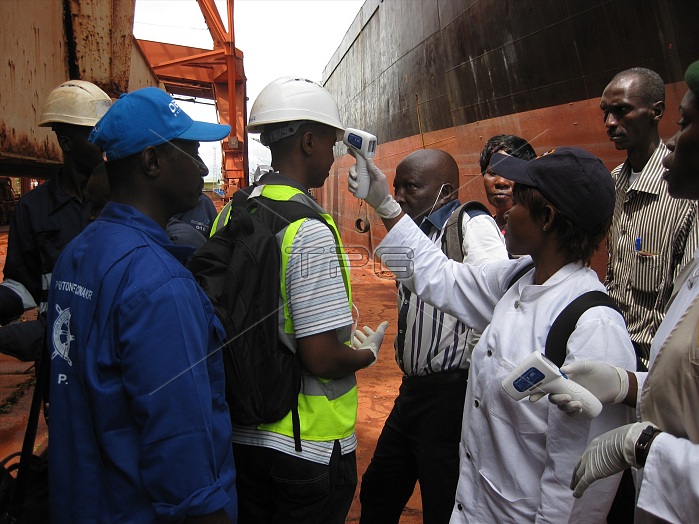
West African city of Conakry, at the capitol's Maritime Port in Guinea, during the 2014 Ebola hemorrhagic fever (Ebola HF) outbreak, which not only affected Guinea, but northern Liberia, Sierra Leone, and Nigeria as well. U.S. Centers for Disease Control and Prevention (CDC) response team members were observing a health screening procedure being conducted on a Port worker. Here, the healthcare screener was in the process of taking a thermal reading on the worker's head using a ThermoFlash infrared thermometer, which monitors the temperature of a person's skin surface, enabling a trained investigator to determine if an individual is exhibiting a fever. ThermoFlash reads the body temperature instantly and without contact. Those exhibiting a fever are then monitored for 21 days, so that they can be isolated, and treated as soon as possible if they develop additional symptoms of Ebola HF. Ebola hemorrhagic fever (Ebola HF) is one of numerous Viral Hemorrhagic Fevers. It is a severe, often fatal disease in humans and nonhuman primates (such as monkeys, gorillas, and chimpanzees). Ebola HF is caused by infection with a virus of the family Filoviridae, genus Ebolavirus. When infection occurs, symptoms usually begin abruptly. The first Ebolavirus species was discovered in 1976 in what is now the Democratic Republic of the Congo near the Ebola River. Since then, outbreaks have appeared sporadically.
| px | px | dpi | = | cm | x | cm | = | MB |
Details
Creative#:
TOP22301041
Source:
達志影像
Authorization Type:
RM
Release Information:
須由TPG 完整授權
Model Release:
No
Property Release:
No
Right to Privacy:
No
Same folder images:

 Loading
Loading